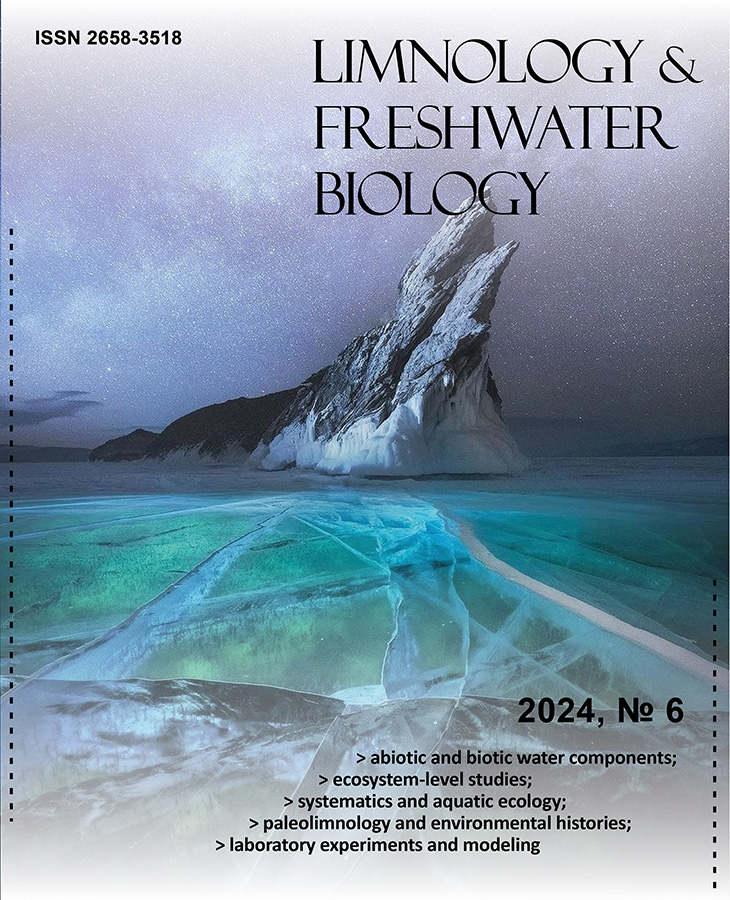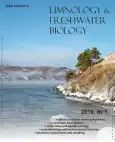Hidden diversity of micro-eukaryotes in Lake Baikal: a metagenomic approach
- Авторы: Mincheva E.V.1, Peretolchina T.E.1, Kravtsova L.S.1, Tupikin A.E.2, Pudovkina T.A.1, Ananyeva I.A.3, Triboy T.I.1, Voylo M.A.1, Bukin Y.S.1,3
-
Учреждения:
- Limnological Institute of the Russian Academy of Sciences
- Institute of Chemical Biology and Fundamental Medicine of the Russian Academy of Sciences
- Irkutsk State University
- Выпуск: № 1 (2019)
- Страницы: 150-154
- Раздел: Статьи
- URL: https://journals.rcsi.science/2658-3518/article/view/283624
- DOI: https://doi.org/10.31951/2658-3518-2019-A-1-150
- ID: 283624
Цитировать
Полный текст
Аннотация
We have studied the diversity and composition of communities of micro-eukaryotes from two localities: area under anthropogenic impact near the town of Baikalsk and reference area, Irinda Bay, based on high-throughput ITS2 rDNA region sequencing. High taxonomic diversity of micro-eukaryotes has been revealed in both localities studied. However, micro-eukaryotic community from the area under anthropogenic impact is depressed, compared to reference area. Analysis of taxonomic diversity has revealed that community from the area under anthropogenic impact has a trend towards a decrease in diversity. Among the detected taxa, Alveolata, Stramenopiles and Fungi prevailed. Sörensen index of OTUs was 65%, which indicates the similarity of communities studied by taxonomic composition. The spectrum of Alveolata and Stramenopiles taxa identified in the area under the anthropogenic impact and the reference area was similar. The main differences were revealed in spectrum of Fungi taxa.
Ключевые слова
Об авторах
E. Mincheva
Limnological Institute of the Russian Academy of Sciences
Автор, ответственный за переписку.
Email: elenakuznetsova01@gmail.com
Siberian Branch
Россия, Ulan-Batorskaya Str., 3, Irkutsk, 664033T. Peretolchina
Limnological Institute of the Russian Academy of Sciences
Email: elenakuznetsova01@gmail.com
Siberian Branch
Россия, Ulan-Batorskaya Str., 3, Irkutsk, 664033L. Kravtsova
Limnological Institute of the Russian Academy of Sciences
Email: elenakuznetsova01@gmail.com
Siberian Branch
Россия, Ulan-Batorskaya Str., 3, Irkutsk, 664033A. Tupikin
Institute of Chemical Biology and Fundamental Medicine of the Russian Academy of Sciences
Email: elenakuznetsova01@gmail.com
Siberian Branch
Россия, Lavrentiev Ave., 8, Novosibirsk, 630090T. Pudovkina
Limnological Institute of the Russian Academy of Sciences
Email: elenakuznetsova01@gmail.com
Siberian Branch
Россия, Ulan-Batorskaya Str., 3, Irkutsk, 664033I. Ananyeva
Irkutsk State University
Email: elenakuznetsova01@gmail.com
Россия, Karl Marx Str., 1, Irkutsk, 664003
T. Triboy
Limnological Institute of the Russian Academy of Sciences
Email: elenakuznetsova01@gmail.com
Siberian Branch
Россия, Ulan-Batorskaya Str., 3, Irkutsk, 664033M. Voylo
Limnological Institute of the Russian Academy of Sciences
Email: elenakuznetsova01@gmail.com
Siberian Branch
Россия, Ulan-Batorskaya Str., 3, Irkutsk, 664033Yu. Bukin
Limnological Institute of the Russian Academy of Sciences; Irkutsk State University
Email: elenakuznetsova01@gmail.com
Siberian Branch
Россия, Ulan-Batorskaya Str., 3, Irkutsk, 664033; Karl Marx Str., 1, Irkutsk, 664003Список литературы
- Asemaninejad A., Weerasuriya N., Gloor G.B. et al. 2016. New primers for discovering fungal diversity using nuclear large ribosomal DNA. PloS one 11. doi: 10.1371/journal.pone.0159043
- Banchi E., Ametrano C.G., Stanković D. et al. 2018a. DNA metabarcoding uncovers fungal diversity of mixed airborne samples in Italy. PloS one 13. doi: 10.1371/journal.pone.0194489
- Banchi E., Stankovic D., Fernández-Mendoza F. et al. 2018b. ITS2 metabarcoding analysis complements lichen mycobiome diversity data. Mycological Progress 17: 1049–1066. doi: 10.1007/s11557-018-1415-4
- Bazzicalupo A.L., Bálint M., Schmitt I. 2013. Comparison of ITS1 and ITS2 rDNA in 454 sequencing of hyperdiverse fungal communities. Fungal Ecology 6: 102–109. doi: 10.1016/j.funeco.2012.09.00
- Bokulich N.A., Mills D.A. 2013. Improved selection of internal transcribed spacer-specific primers enables quantitative, ultra-high-throughput profiling of fungal communities. Applied and Environmental Microbiology 79: 2519–2526. doi: 10.1128/AEM.03870-12
- Charvet S., Vincent W.F., Lovejoy C. 2014. Effects of light and prey availability on Arctic freshwater protist communities examined by high-throughput DNA and RNA sequencing. FEMS Microbiology Ecology 88: 550–564. doi: 10.1111/1574-6941.12324
- Chiu C.H., Wang Y.T., Walther B.A. et al. 2014. An improved nonparametric lower bound of species richness via a modified good–turing frequency formula. Biometrics 70: 671–682. doi: 10.1111/biom.12200
- Debroas D., Domaizon I., Humbert J.F. et al. 2017. Overview of freshwater microbial eukaryotes diversity: a first analysis of publicly available metabarcoding data. FEMS Microbiology Ecology 93: 1–14. doi: 10.1093/femsec/fix023
- Dixon P. 2003. VEGAN, a package of R functions for community ecology. Journal of Vegetation Science 14: 927–930. doi: 10.1111/j.1654-1103.2003.tb02228.x
- Doyle J.J., Dickson E.E. 1987. Preservation of plant samples for DNA restriction endonuclease analysis. Taxon 36: 715–722. doi: 10.2307/1221122
- Edgar R.C. 2013. UPARSE: highly accurate OTU sequences from microbial amplicon reads. Nature Methods 10: 996. doi: 10.1038/nmeth.2604
- Izhboldina L.A. 2007. Guide and key to benthonic and periphyton algae of Lake Baikal (meio – and macrophytes) with short information about their ecology. Novosibirsk: Nauka-Center. (in Russian)
- Johnson P.T., Longcore J.E., Stanton D.E. et al. 2006. Chytrid infections of Daphnia pulicaria: development, ecology, pathology and phylogeny of Polycaryum laeve. Freshwater Biology 51: 634–648. doi: 10.1111/j.1365-2427.2006.01517.x
- Kagami M., Amano Y., Ishii N. 2012. Community structure of planktonic fungi and the impact of parasitic chytrids on phytoplankton in Lake Inba, Japan. Microbial Ecology 63: 358–368. doi: 10.1007/s00248-011-9913-9
- Kammerlander B., Breiner H.W., Filker S. et al. 2015. High diversity of protistan plankton communities in remote high mountain lakes in the European Alps and the Himalayan mountains. FEMS Microbiology Ecology 91. doi: 10.1093/femsec/fiv010
- Kravtsova L.S., Izhboldina L.A., Khanaev I.V. et al. 2012. Disturbances of the vertical zoning of green algae in the coastal part of the Listvennichnyi gulf of Lake Baikal. Doklady Biological Sciences 447: 350–352. doi: 10.1134/S0012496612060026
- Letcher P.M., Powell M.J., Chambers J.G. et al. 2004. Phylogenetic relationships among Rhizophydium isolates from North America and Australia. Mycologia 96: 1339–1351. doi: 10.1080/15572536.2005.11832883
- Mikhailov I.S., Zakharova Y.R., Bukin Y.S. et al. 2019. Co-occurrence networks among bacteria and microbial eukaryotes of Lake Baikal during a spring phytoplankton bloom. Microbial Ecology 77: 96–109. doi: 10.1007/s00248-018-1212-2
- Mueller G.M., Foster M.S., Bills G.F. 2011. Biodiversity of fungi: inventory and monitoring methods. New York: Academic.
- Shannon C.E. 1948. A mathematical theory of communication. Bell Labs Technical Journal 27: 379–423. doi: 10.1002/j.1538-7305.1948.tb01338.x
- Šlapeta J., Moreira D., López-García P. 2005. The extent of protist diversity: insights from molecular ecology of freshwater eukaryotes. Proceedings of the Royal Society B: Biological Sciences 272: 2073–2081. doi: 10.1098/rspb.2005.3195
- White T.J., Bruns T.D., Lee S.B. et al. 1990. Amplification and direct sequencing of fungal ribosomal RNA genes for phylogenetics. In: Innis M.A., Gelfand D.H., Sninsky J.J. et al. (Eds.), PCR protocols: a guide to methods and applications. New York, pp. 315–322.
- Yi Z., Berney C., Hartikainen H. et al. 2017. High-throughput sequencing of microbial eukaryotes in Lake Baikal reveals ecologically differentiated communities and novel evolutionary radiations. FEMS Microbiology Ecology 93. doi: 10.1093/femsec/fix073
- Zhang H., Huang T., Chen S. 2015. Ignored sediment fungal populations in water supply reservoirs are revealed by quantitative PCR and 454 pyrosequencing. BMC Microbiology 15: 44. doi: 10.1186/s12866-015-0379-7
- Zhang H., Jia J., Chen S. et al. 2018. Dynamics of bacterial and fungal communities during the outbreak and decline of an algal bloom in a drinking water reservoir. International Journal of Environmental Research and Public Health 15: 361. doi: 10.3390/ijerph15020361
Дополнительные файлы










